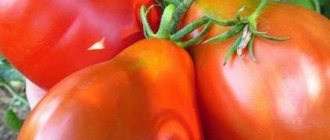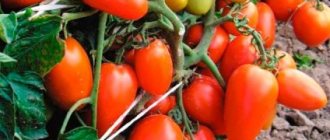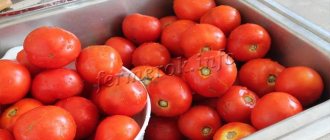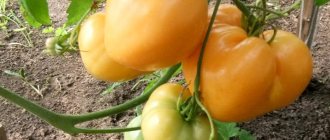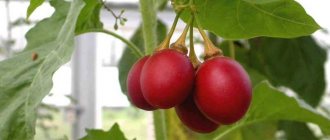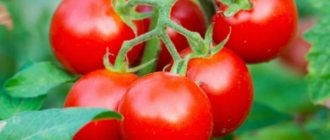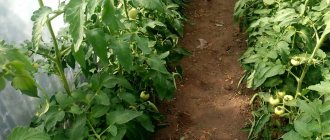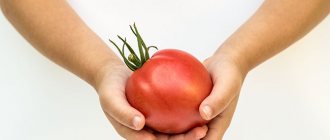Description of the variety
The Buyan variety is the result of the work of Siberian breeders: in 2012 it was bred specifically for cultivation in conditions of short and cool summers. It can be cultivated both in greenhouses and in open ground. The tomato is easy to care for, bears fruit well, and is ideal for homemade preparations.
Other name and varieties
It is not for nothing that people nicknamed it Fighter - this variety is not susceptible to climate change: it safely survives the cold and does not suffer from drought. Viruses and fungal infections are also not scary for him - the Fighter has excellent immunity to various kinds of microorganisms.
The fruits of this variety can be red or yellow. At the same time, the yellow variety of Buyan is no different in taste from the red one: the differences are only in color and in a more elongated shape, as can be seen in the photo.
Distinctive features
The Buyan tomato is a pure-varietal plant, bred not by crossing several varieties with each other, but by selecting the best plants. Its seeds retain all parental characteristics, which means that all characteristics of the plant are inherited.
This tomato belongs to a low-growing type of plant (determinant variety), that is, when it reaches a certain size, it stops growing, which is very convenient for gardeners: there is no need to tie up bushes or remove excess leaves. Thanks to this, Buyan is also good to grow in a greenhouse.
The plant tolerates temperature changes between day and night, short rainy summers, and high humidity. The period from sprouts to fruiting is one hundred days. Differs in early ripening.
Fruit characteristics, yield
The fruits of Buyan have a rounded, elongated plum-shaped shape. A ripe fruit can weigh on average from 80 to 150 g, has fleshy pulp and thick smooth skin, and a sweet and sour taste. There are few seeds in the pulp: one fruit has 3-6 seed chambers.
Pest and disease control
If the requirements of agricultural technology are met exactly, then the Buyan variety does not suffer from the invasion of parasites or diseases. However, you need to help the plants, so you should not refuse preventive treatments. It is important to know the peculiarity of red Buyan tomatoes. Green spots may appear on the fruit. This is not a disease; after the tomatoes are fully ripened, the spots disappear. The second feature is that tomatoes are prone to cracking when there is excess moisture or nutrition and lack of light.
Preventive treatments with Bordeaux mixture are needed against late blight, calcium nitrate against blossom end rot of fruits.
Among the pests, the Colorado potato beetle, aphids, spider mites or mole crickets are annoying. The methods of fighting are traditional.
How to grow seedlings
With the right approach, Buyan bears fruit regularly throughout its seasonal life. But in order to reap a bountiful harvest, you should take care of the seedlings in advance. Seeds can be bought in the store, but it is better to collect them yourself by the beginning of autumn from the largest fruits.
Seed preparation
To obtain seedlings, smooth, even seeds without defects are used.
Regardless of whether your seeds are purchased or collected yourself, before planting it is recommended to provide them with protection from viruses and infections - pickle them in a solution of potassium permanganate. The main thing here is not to overcook the seeds: 15 minutes is enough.
After potassium permanganate, the seeds should be washed with running water. Immediately before planting, they need to be kept in salt water - this increases the viability of future plants. Seeds from well-known manufacturers do not need to be subjected to such treatment - they are completely ready for sowing.
Container and soil
For planting, you can use whatever is at hand: ceramic pots, wooden or plastic boxes, cups, etc. However, it must be taken into account that the height of the sides should not exceed 10 cm. It is also worth taking care of drainage.
If the soil for seedlings is taken from the garden bed, then it needs to be disinfected, since the likelihood that it contains fungal infections and pest larvae is very high. You can disinfect the soil by holding it in a well-heated oven or pouring boiling water over it. You can etch with the same solution of potassium permanganate.
For your information. For reliable disinfection, soil treatment methods can be combined with each other.
For greater safety, it is better to buy already treated soil in gardening stores.
Sowing
By the end of March, you can start planting, sowing the seeds into the soil at a distance of 2 cm from each other and no deeper than 1 cm. A stable temperature of + 20-25 degrees should be maintained in the room with the seedlings. But the soil cannot be overheated; the seeds may die.
If it is not possible to provide constant heat, you can cover containers with seedlings with film to create a certain microclimate. If sowing is organized correctly, the first shoots will appear in 6-7 days.
Growing and care
In order for the seedlings to grow faster, it is necessary to create conditions for additional lighting.
After seedlings have appeared in the form of two or three leaves, it is necessary to transplant the seedlings into larger containers.
It is useful to feed the sprouts with an ash solution: 1 tablespoon of wood ash per 1 liter of cold water. There is no need to get carried away with fertilizing: 2-3 times before picking plants is enough.
Before planting in the garden, seedlings can be gradually accustomed to the outside temperature: 12 days before transplanting, you need to gradually reduce the temperature in the room and ventilate it frequently. If possible, take pots of seedlings outside for a while.
Young tomatoes are planted in the ground as the soil warms up: the optimal temperature is 15 degrees Celsius. 10-15 days after transplantation, during the formation of the ovary, the plants can be given phosphorus-nitrogen fertilizing. When Buyan is flowering, feed it with mineral and organic fertilizers; it is recommended to include potassium sulfate. After this, add fertilizer two more times - during active plant growth and fruiting.
Since Buyan is a low-growing shrub, it is important to correctly form the bush at the growth stage - 3-4 stems. A plant formed into one stem will bear little fruit.
Watering tomatoes can be done in the usual way or by drip, but always at the root. Do not forget about weeding and removing rotten and dead leaves and stems, as this is a fertile environment for the development of diseases and pests.
Growing rules
Cultivating the Buyan variety is not at all difficult. Even novice vegetable growers can grow it. It is best to calculate the sowing time yourself. It depends on the weather conditions of the current season, the method of cultivation (open ground or greenhouse), and the recommendations of the lunar calendar. When grown in a region with cool summers, the seedling method is suitable. Typically, the sowing time in the middle zone falls at the beginning of March, in the southern regions in February, and in the northern regions at the beginning of April. Planting of seedlings in a permanent place is carried out at the age of 55 days.
Properly grown seedlings take root well in a permanent place
Before sowing, the seeds must be treated with a solution of potassium permanganate.
Soil for seedlings can be bought at the store or prepared yourself. To do this, you just need to take turf soil and mix it with humus in a 1:1 ratio, and then add a little peat (1/4 of the total volume).
It is best to take a planting box for sowing tomato seeds. This will save space until the seedlings are planted. When the seedlings have 2 true leaves, you will need to transplant the tomatoes into separate cups.
For seedlings to grow powerful and healthy, you need:
- Fill the container with the prepared soil mixture.
- Lightly compact and moisten.
- Make grooves 1.5 cm deep, spread tomato seeds, sprinkle with soil.
- Water well.
- Cover with glass or film and place in a warm place.
- After the Buyan tomatoes sprout, remove the film and transfer the seedlings to the light.
- Monitor timely watering of seedlings.
Important! Tomato seedlings do not like waterlogging and may get sick. - Feed the seedlings after diving with complex fertilizer for seedlings.
- 2 weeks before transplanting into the ground, begin hardening off the plants.
Video about the stages of seedling growth:
Subject to the requirements of agricultural technology, seedlings grow strong and healthy
When the threat of frost has passed, you can plant the seedlings in open ground. When growing in greenhouses, this condition is not necessary.
The planting scheme for tomato bushes of the Buyan variety is 7-9 plants per 1 sq. m area.
If you maintain planting density, the plants develop much better
As soon as the plants take root, it is necessary to carry out the following basic activities:
- Watering. It is best to water tomatoes after sunset. It is important to ensure that the soil does not dry out. But overwatering is also harmful. Therefore, the frequency of watering must be adjusted depending on weather conditions.
- Feeding. Required throughout the growing season. The brawler responds well to complex mineral compositions. If desired, they can be replaced with organic matter, wood ash, iodine, yeast, hydrogen peroxide or boric acid. Before flowering, nitrogen is needed more; after fruit formation, potassium is needed.
- Loosening and weeding are also in rhythm so that the beds are not overgrown with weeds and the roots have enough air. Mulching beds works well against weeds.
The Fighter variety fully lives up to its name. Tomatoes can withstand unfavorable weather conditions or minor disturbances in agricultural practices. There is no need to pin the bushes; tying will help with heavy loads on the branches.
Possible difficulties when growing the Buyan variety
For beginning gardeners, not everything always goes smoothly - both in germinating seeds and in further caring for plants.
Problems with seedlings
All conditions have been created, artificial lighting has been established, the seeds are carefully covered with film, but there are no sprouts. What is the reason? In addition to low-quality seeds, the following reasons can lead to this result:
- You may have planted the seeds too deeply in soil that is too heavy for them. The seeds simply suffocated under a layer of airtight soil;
- drainage is not thought out: the soil is peroxidized and fermented, which causes the seed to rot;
- you placed the box with seeds in a very hot room - perhaps next to heating appliances. The seeds could have become soggy from the oversaturation of steam.
Problem with sprouts
Your seeds have sprouted, but they do not bring joy: they are too faded and elongated, as if rickety. This may be for the following reasons:
- lack of light - you should take care of artificial lighting directly above the box with seedlings;
- When planting the seeds, you placed them too close to each other. Transplanting some of the sprouts into another container will help here. But such forced picking slows down the growth of the plant by 12-15 days, this must be taken into account before planting in open ground;
- Perhaps you overdid it with fertilizers, in which case it is better to transplant the seedlings into another, more “calm” soil.
Diseases
Buyan is resistant to most diseases, but if a greenhouse or garden is infected through the soil or garden pests (for example, aphids), then it may also be at risk.
Fungal diseases:
- Gray rot is a disease that affects closely planted plants. Characteristic signs of the disease are a white fluff-like coating on the fruits, spots on the leaves and stems. The drugs “Fundazol” or “Switch” will help fight the disease.
- Fomoz (brown rot) - the entire above-ground part of tomatoes is affected. The disease can be detected by the appearance of the leaves: they are covered with brown spots, which increase with the progress of the disease. If phomosis affects the fruits, then small black spots are visible on them, which also grow. In this case, the core of the fruit is also affected. In the initial stage of the disease, preparations based on copper oxychloride and Bordeaux mixture will help.
- Blackleg - a fungus that attacks the root system of a plant. Conditions for its reproduction can be the constant use of the same land, temperature changes, and high humidity. The fight against the disease will consist of treating the contaminated soil: watering with a solution of potassium permanganate, loosening, and, if necessary, replacing the soil.
Bacterial diseases:
- Bacterial cancer - bacteria infect the vessels of the plant, it begins to wither before our eyes. The disease progresses from the bottom up: from the lower leaves, which curl and wither, to the fruits, where black spots appear on them.
- Necrosis of the stem core - manifests itself during fruiting. Light spots appear on the leaves, and the leaves themselves curl. As a result of the disease, the tomato stem becomes hollow and brittle from the inside, and the plant dies.
- Bacterial fruit spotting affects early-ripening varieties planted in early spring. All parts of the plant suffer, the disease manifests itself in the form of growing spots on the leaves and stems. When blooming, the flowers are affected - they dry out.
In case of bacterial diseases, it is necessary to carry out protective measures in the form of weeding and removal of affected parts of the plant. If signs of disease are detected, plants must be sprayed with Abiga-Pik solution. The preparations “Fitolavin-300”, “Gamair” and “Baktofit” are recommended as the most effective in the fight against bacterial diseases.
For your information. Greenish spots may appear on the fruits of the Buyan variety. This is not a disease, but a feature of the variety. As the fruit ripens, the spots disappear.
Pests
Buyan tomatoes grown in greenhouses are most often attacked by spider mites. The tick feeds on the sap of the plant, biting through its leaves, which as a result begin to turn yellow, become covered with small dots and dry out.
If the mite is found in abundance on plants, a cobweb will be visible - a waste product of the pest. If you see cobwebs on your tomatoes, it’s time to act, because this is a sign that the plants are at high risk and may die.
Spraying the bushes with a soap solution will help get rid of the tick. Since mites cannot tolerate the taste and smell of sulfur, treating the greenhouse with sulfur smoke will be effective.
Tomatoes in open ground can also be attacked by mites. If traditional methods do not help, then it is recommended to use the drugs “Plant-Pin”, “Ethisso”, “Actellik”.
Features of planting and care
Pre-hardened planting material can be planted on an open ridge at a stable soil temperature of up to +15°C. It is recommended to place no more than 8 shrubs per area of 1 m2. The ridges should be located on the south side and should not be exposed to drafts.
Tomato Bugai
It is recommended to mulch the plantings using one of the following materials:
- straw;
- peat.
Note. Mulching will help keep the soil moist for a longer period of time and will also stop the development of weeds.
Unpretentiousness in care implies compliance with the following basic recommendations for agricultural technology:
- For irrigation work, warm, settled water should be used;
Note! It is recommended to water tomato plantings in the morning or after the sun has set.
- Carrying out loosening activities and removing weeds involves regularly performing these two garden activities. The soil must be loosened after each watering, avoiding deformation of the root system;
Important! Weeds can be a source of infection for various diseases
- Fertilization of plantings can begin 10 days after transplantation. A mineral complex based on nitrogen-phosphorus substances should be added.
Gorgeous harvest
Note! When entering the fruiting stage, this tomato must be fertilized with useful compounds enriched with potassium
How to grow seedlings
The month of March is considered the beginning of sowing seed material. Each seed is placed two centimeters deep in the ground. The procedure for sowing is as follows:
- Compact the soil;
- Sow seed;
- Mix the soil and peat;
- Sprinkle the seeds with a thin layer of mixed soil.
To water seedlings, a sieve or spray bottle is usually used. Boxes covered with film material must be placed in a warm room. The film cover is removed when the seedlings have germinated. In addition, planting material must be placed on a well-lit area of the window sill.
No seedling treatment
Picking begins after the germination of 2 leaves. Before planting seedlings, they must be fertilized 2 times. The hardening procedure is carried out a week before planting in the ground. You can start planting sprouted seedlings only after the final end of night frosts.
Note! Before entering the flowering stage, tomatoes must be fertilized with potassium
About diseases and pests
The Buyan varietal tomato is resistant to most diseases caused by fungal and viral outbreaks. However, poor care of the plant makes it susceptible to a number of diseases, such as:
- Late blight is the most common disease affecting tomato bushes. Excessive air humidity and temperature changes are considered a favorable environment for the occurrence of late blight. The affected area is foliage and the tomatoes themselves, which acquire a brown tint. To treat late blight in tomato bushes, spray preparations are used, the main component of which is copper;
Helpful advice. In order to avoid burns when making Bordeaux mixture, the required percentage is checked using a nail: if it turns red, lime is added to the mixture.
- Gray rot that stains Buyan tomatoes with dark spots. The cause of the disease is a deficiency of moisture and calcium. You can get rid of gray mold damage by spraying the plantings with calcium nitrate;
- Cracking of vegetables can begin with excessive waterlogging, excess fertilizer, insufficient lighting, deformation by gusts of wind and too many fruits on one bush.
A number of measures should be taken as preventive measures:
- water the plantings in a timely manner with warm water: in the morning or evening;
- remove weeds;
- apply the required amount of mineral fertilizers.
The nuances of growing Buyan in open ground and in a greenhouse
The Buyan tomato, as an early-ripening, low-growing variety, is ideal for growing in a greenhouse. It does not bush and does not create thickets; it does not need to be pinched or tied up.
Here are some recommendations for growing Buyan in a greenhouse:
- It is better to plant tomatoes along the wall of the greenhouse, and not across it - this way they will have more access to light.
- Create rows so that it is convenient to approach everyone: side rows along the walls, central rows in the center.
- Do not overfeed the soil with seedlings with fertilizers with a high nitrogen content.
- Tomatoes are light-loving plants, so access to light should be maximum.
- The greenhouse must be regularly cleaned, dead branches and leaves must be removed and taken outside, otherwise pests may appear.
When planting tomatoes in open ground, it is also necessary to adhere to certain standards, because properly planted bushes are the key to plant health:
- The soil in the beds must be prepared for planting in the fall;
- tomatoes grow well in the area after cucumbers, carrots, onions and cabbage;
- the distance between rows should not be less than 40 cm;
- Tomatoes can be planted in beds in a checkerboard pattern and parallel to each other, but the distance between the bushes must be sufficient to ensure access to processing each bush;
- Weeding, loosening the soil, removing yellowed and rotten parts of the plant are mandatory activities during the season.
Harvesting and application
Buyan produces a harvest three months after germination, so if your tomatoes sprouted in April, then in June you will receive the first fruits. They need to be collected regularly, but it is better to leave one ripe fruit on each bush, as it contributes to the ripening of the remaining fruits.
If you miss time, the fruits will become overripe, which means they will lose their beneficial qualities and appearance, and become loose and tasteless. If you want fresh tomatoes for the table, it is better to pick them when they are ripe and bright red or yellow.
Buyan tomatoes are an excellent product for canning. Their fruits, both ripe and unripe (green), can be canned, pickled and salted. It should be borne in mind that these tomatoes do not last long when fresh. It’s better if they go from the garden to canned food or juices. Thanks to its dense pulp, the tomato is suitable for both drying and freezing.
Why gardeners choose Buyan tomato, pros and cons
It was the drought and cold resistance of the Fighter variety that made it so popular.
These 2 characteristics are important for summer residents who rarely come to their dacha. Tomatoes tolerate irregular watering without problems; the ovaries and flowers do not fall off in the heat, since the variety is heat-resistant. The bushes do not require shaping. This is another advantage of the Buyan tomato. Little time is required for care. Beginning gardeners should take this variety into service. Even with a complete lack of experience, he will not leave you without a harvest.
From the point of view of immunity, everything is also good. Buyan has a low susceptibility to bacterial infections. It is practically not affected by the tobacco mosaic virus. Due to its precocity, it manages to escape late blight.
Advantages and disadvantages of the variety
Although Buyan was bred for regions with cold weather conditions, it has become popular everywhere, as it has a number of advantages that farmers love. One of them is harvest abundance: up to 8 kg of fruits are obtained from one square meter. At the same time, the variety is unpretentious: it patiently tolerates aridity and temperature changes. Such common diseases as late blight and tobacco mosaic are not a threat to Buyan.
Many gardeners also liked the appearance of the fruit: medium-sized, neat, smooth, shiny. During heat treatment, the tomato skin remains intact and does not crack. In home canning and drying, all the taste and aroma are preserved.
Farmers include the following disadvantages of the variety:
- inability to store fresh for a long time;
- When ripening on the bush, the skin of tomatoes often bursts. This fact in itself does not cause damage, but microbes that are harmful to humans can settle in the cracks.
Description and characteristics of tomato Fighter
The variety was bred at the Institute of Cytology and Genetics of the Siberian Branch of the Russian Academy of Sciences. In 1998, the tomato was submitted for state variety testing, and in 2000 it was included in the State Register of the Russian Federation. Fighter is recommended for cultivation in personal gardens and farms in open and closed ground. It has performed well in various regions, but is especially popular in northern latitudes. The variety is also successfully grown in Moldova and Ukraine.
Buyan is another common name for the described variety. Some seed manufacturers indicate both names on the packages, but the tomato is included in the State Register as Fighter. The State Register also includes the Buyan yellow variety, which is often mistaken for a variety of tomato called Boyan (Buyan).
Infographics: brief characteristics of the Fighter tomato variety according to the State Register data
Brief characteristics of the Fighter variety according to the State Register data
The plant is not tall (42–45 cm), belongs to the standard determinant (having limited growth) type. The bush is sparse, with medium branching and foliage. Dark green leaves of medium size, with pronounced corrugation. The inflorescences are simple, they begin to form above the 6th–7th leaf. After 1–2 sheets the following brushes are laid. The peduncle has an articulation.
The variety is early ripening; fruits begin to ripen 95 days after germination. The timing of ripening may be slightly affected by climatic and weather conditions. Information about yields varies quite widely:
- The State Register indicates an indicator of 2.3 kg/m2.
- Other sources claim yields of 5–9 kg/m2.
- Experienced gardeners claim that with dense plantings of compact plants (8–9 bushes per 1 m2), you can harvest over 20 kg of fruit per square meter.
The yield of commercial products reaches 72%. Unripe tomatoes ripen quickly: this property is especially valuable for regions with short summers. Transportability is good.
With appropriate agricultural technology, a high yield of Fighter tomatoes can be grown in a small area
The weight of the fruit, according to the State Register, is 67–88 grams; some seed packages indicate that the first tomatoes reach 180 grams. The shape is cylindrical, the surface is smooth, the skin is dense. Unripe tomatoes are green in color with a dark green spot at the point where the stalk is attached; when ripe, they turn red. There are 3-4 slots inside.
The red fruits of the Fighter tomato are cylindrical in shape and have a dense, smooth skin.
The taste is good, but, like most early ripening varieties, it is not exquisite. The pulp, according to reviews, is fleshy and not tough. The fruits are used universally: until large-fruited salad tomatoes appear, they can be consumed fresh and then processed. Tomatoes are excellent for pickling and canning: thanks to their fairly dense skin, their integrity is not compromised. The shape and size of the tomatoes allow them to be compactly placed in jars. The products can be processed into juice or puree, and also used as an ingredient in various dishes.
The size and shape of Fighter tomatoes are ideal for placing in jars
The fighter is drought-resistant, which is a big advantage for summer residents who do not have the opportunity to regularly water their plantings. Gardeners who grew the described variety note its cold resistance and resistance to changes in day and night temperatures. Plants are resistant to tobacco mosaic virus and moderately resistant to bacterial diseases. Reviews note that even tomatoes lying on damp ground are not susceptible to rot.
Farmer reviews
Let's consider the reviews of summer residents who have already grown the Buyan tomato.
Margarita: “I bought a bag because I had already heard that this variety is “for the lazy.” The seeds sprouted with a bang. I didn’t particularly choose the place for the seedlings: the only free space was in the shade of the tree. Due to the fact that there was not enough light for them, the tomatoes appeared later than other varieties that I planted on the site. But I collected fruits regularly. The bush is low, shaggy, it does not need to be trimmed or tied up. Just a beauty, not a plant!”
Alina: “We are beginners as gardeners, but Buyan’s seedlings did not disappoint: we took them to the dacha without any hassle, and they were still lush, fresh, nothing wilted or broke. Just as they were planted in the ground, they grew - no worries with them, no hassle! The tomatoes themselves are oval, smooth, a sight for sore eyes. I made salads from them all summer. True, the skins on them often burst, but since I immediately processed them in the kitchen, it was okay, not fatal.”
Igor: “It’s a good variety, it didn’t disappoint. For the sake of experiment, I planted them in the greenhouse with other tomatoes. What was surprising was that the seedlings, unlike other varieties, did not stretch. I didn't bother with it much. Planted in April, starting in June, the bushes bore fruit all summer. The harvest was abundant; every day I left the greenhouse with two full buckets of fruit. I’ll definitely plant it next year.”
Secrets of high yields of tomato Fighter
Gardeners do not complain about tomato productivity. Small bushes yield a harvest in any weather. Experienced gardeners use simple agrotechnical techniques that can prolong fruiting and improve the quality of fruits.
Feeding
Feeding is especially important in bad weather. During cold weather, root fertilization does not bring any effect, so the emphasis is on foliar feeding:
- 10 l of water, 1 tsp of complex mineral fertilizer, humate (exactly according to the instructions);
- low-fat milk - 1 part, water - 10 parts.
Important!
It is necessary to moisten the lower part of the leaves well with liquid fertilizer. In the Buyan tomato, most of the stomata are located there.
Disease Prevention
Buyan tomato bushes rarely suffer from late blight.
Preventive treatments are necessary if there have been cases of infection in the garden or in neighbors this or the previous season. For preventive purposes, healthy leaves and stems of the Fighter tomato are treated with Bordeaux mixture. Spraying is repeated every 10 days. They use spray bottles with dispersed spraying; if this is not available, they resort to the “old-fashioned” option - moisten a broom in the solution and spray the tomato ridge. If signs of infection appear on the leaves, use systemic drugs:
- Acrobat;
- Oksikhom.
Fertility restoration
Proper soil care and systematic restoration of fertility guarantee high yields of Fighter tomato. In autumn, the area is cleared of roots, stems, weeds, and dug up. Add humus 1 bucket per 1 m².
In spring, mineral fertilizers are used. Applying manure can cause late blight, so before digging, granules of complete mineral fertilizer are scattered over the ridge. Choose fats that contain microelements and a complete N: P: K complex.
Crop rotation
In a garden where they try to follow the rules of crop rotation, vegetable crops do not get sick. The Buyan tomato has excellent immunity, but when planting it you also need to follow the rules:
- create a ridge away from the potato plot;
- Do not plant after nightshade vegetable crops (tomatoes, potatoes, peppers, eggplants).
Soil treatment against infection and pests
Experienced gardeners have many original techniques for clearing the soil of pathogens and pests. When growing Fighter tomatoes, you can use one of these. In the fall I will sow winter rye.
Comment!
When rye stalks rot, Bacillus subtilis multiplies in the soil and destroys harmful fungi.
In spring it will turn green. Pull it out in place of the holes and use it as mulch. Plant seedlings. Seedlings surrounded by rye will take root faster. During the day she does not suffer from the sun, and at night from cold weather. A little later, the rye should be cut off and left on the ridge.


